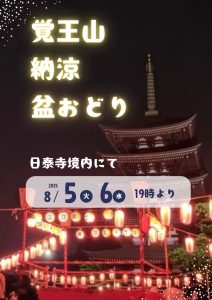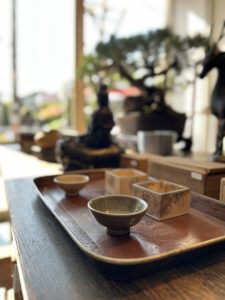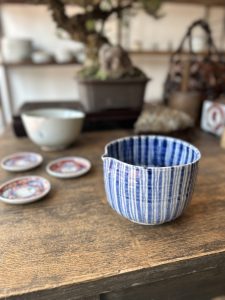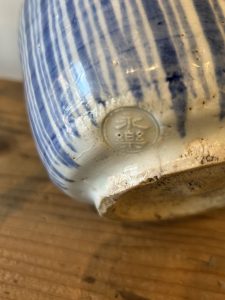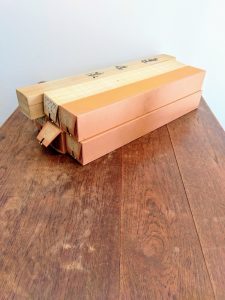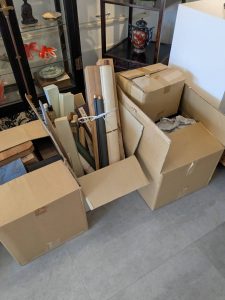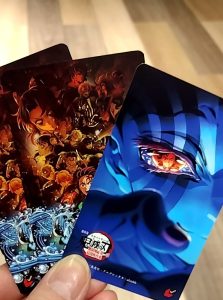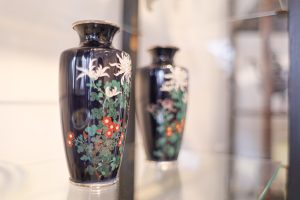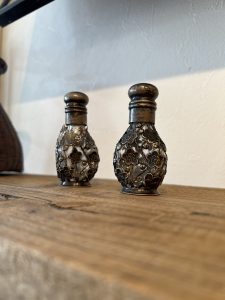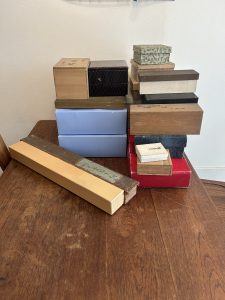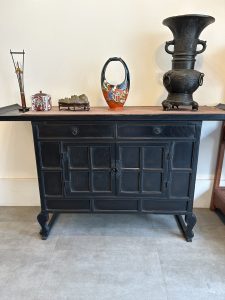暑気払いを執り行いました(愛知県名古屋市千種区姫池通 骨董買取 古美術風光舎)
2025.07.30
熱風に耐えられず日陰を求めて木の下に避難すると、蝉の声が一斉に上から降ってくるようで暑さが倍増しました。短い命を懸命に生きる蝉には何の罪もないのですが、つい耳をふさいでしまいます。
皆さまも色々と暑さ対策をされているでしょうが、やはり体力をつけるのが一番!ということで、古美術風光舎名古屋店では、恒例の暑気払いを執り行いました。
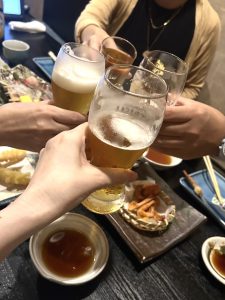
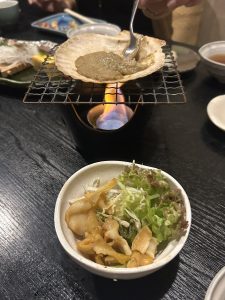
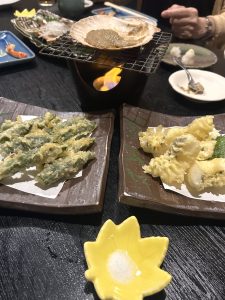
すみません、揚げ物が多く写っておりますが、新鮮なお刺身やお寿司が美味しいお店でございました。食べることと話すことに夢中で写真を撮り忘れておりました…。
店主、ごちそうさまでした。いつもありがとうございます。
暑気払いとは今では夏のイベントとして会社の同僚や友人との会食を指すことが多いですが、古くは平安時代、貴族の間で行われていた行事が始まりのようです。氷室の氷を口にふくんだり、冷たい甘酒をのんで暑気を払っていたとか。甘酒は飲む点滴ともいわれるほど栄養価が高く、今でも夏の熱中症予防には最適の飲み物とされています。甘酒の効能は重々承知してはいるのですが、やはり冷たいビールでのカンパーイに勝るものはありません。
それにしましてもこの乾杯、今では世界の共通儀式ともいえるのではないでしょうか。いつものごとくその起源が気になりだしました。
起源には諸説あるようで、ヨーロッパにおいて宗教的儀式で用いられた「神酒」を飲む際に悪魔を追い払う意味でグラスを合わせて音を立てた。他にはグラスを合わせることで互いのお酒を混ぜたり、同時に飲むことで毒が混入していないことを証明したなどという物騒な説もありました。
日本で最初にお酒の席で「乾杯」の発声がされたのは1854年、日英和親条約が結ばれた際に開かれたパーティでのことだといわれています。イギリス人が英国式の乾杯の儀式を教えたところ、日本側が戸惑って静まりかえってしまったそうです。そこで外交担当の井上清直という人物が突然立ち上がり、大声で「かんぱい!」と叫んだそうで、それがウケて皆大笑いしたとの記述が残っているそうです。今では乾杯の意味は「杯の酒を飲み乾かすこと」となっていますが、当時なぜ彼がとっさに乾杯と叫んだのかは定かではなく、記述だけではともすれば滑稽で間抜けな人物という印象が残ります。外交の上で重要な場面に出席した人ですので間抜けな訳はありませんよね。
本人に尋ねてみたいところですが、そうもいかず妄想を膨らませておりましたら、平安時代の漢文の資料に「乾杯」の文字があるとのこと。現在のような使い方ではないようですが中国からの漢語の一つだとみられています。そういえば中国ではお酒を一気飲みする時に「干杯(がんべい)!」と言いますね。謎解きのようになってきましたが、井上清直が中国語にも精通していたとしたらかなり優秀な人物だったといえます。
もしかしたら彼の単なる思い付きだった、ということもありえますが…。
西洋文化が盛んに取り入れられた明治期以降、ビールなどの洋酒の浸透に伴い乾杯の文化も広まり、今では楽しい宴の始まりには欠かせないものとなっています。昨日の風光舎の宴でもメンバーが時間差で加わるたびに何度乾杯したでしょうか。
おいしい食事で古美術風光舎の店主およびスタッフ一同、下半期に向け気合をいれましたので、皆さま今後ともよろしくお願い申し上げます。
それでは、また次の機会に。(スタッフH)
Unable to withstand the heat, I sought shade under a tree, but the sound of cicadas chirping above me made the heat feel twice as intense. The cicadas, living their short lives to the fullest, are not to blame, but I couldn’t help covering my ears.
I’m sure everyone has their own ways of coping with the heat, but building up your physical strength is still the best! With that in mind, the Nagoya branch of Kobijyutsu Fukuosha held its annual summer heat-beating event.
Sorry for the many photos of fried foods, but the restaurant served delicious fresh sashimi and sushi. I was so busy eating and talking that I forgot to take photos…
Thank you, owner, for the meal. Thank you always.
While summer heat-beating events are now often associated with company colleagues or friends gathering for a meal, they apparently date back to the Heian period. Nobles would put ice from ice houses in their mouths or drink cold sweet rice wine to ward off the heat. Sweet rice wine is said to be as nutritious as an IV drip and is still considered an ideal drink for preventing heatstroke in summer. While I am well aware of its benefits, there’s nothing that beats a cold beer for a toast.
That said, this toast is probably now a common ritual around the world. As usual, I became curious about its origins.
There are various theories, such as the idea that in Europe, during religious ceremonies where “sacred wine” was drunk, people clinked their glasses to make a sound to ward off evil spirits. Another theory, which sounds a bit alarming, suggests that clinking glasses was done to mix each other’s drinks or to prove that no poison had been added by drinking simultaneously.
The first recorded use of the term “cheers” at a drinking occasion in Japan was in 1854, at a party held to celebrate the signing of the Japan-UK Friendship Treaty. When the British taught the Japanese the British-style toast ritual, the Japanese were reportedly confused and fell silent. At that point, a diplomat named Inoue Seizaburo suddenly stood up and shouted “Kanpai!” loudly, which was well-received, and everyone burst into laughter, according to records. While the meaning of ‘kanpai’ today is “to drink the sake in one’s cup dry,” it is unclear why he suddenly shouted “kanpai,” and the records alone might give the impression of a comical or foolish person. Since he was a person who attended an important diplomatic occasion, he couldn’t have been foolish, right?
I would like to ask him myself, but since that’s not possible, I let my imagination run wild, and then I found out that the word “kanpai” appears in Chinese texts from the Heian period. It seems that it was not used in the same way as it is today, but it is believed to be one of the Chinese words that came from China. Come to think of it, in China, when drinking alcohol in one gulp, they say “ganbei!” This has turned into a mystery, but if Inoue Seizaburo was also proficient in Chinese, he must have been a highly capable individual.
Perhaps it was just a whim of his…
Since the Meiji period, when Western culture was actively adopted, the culture of “ganbei” has spread alongside the popularity of Western alcoholic beverages like beer, and it has become an indispensable part of joyful gatherings. At yesterday’s Fukousha gathering, how many times did we toast as members joined in at different times?
With delicious food and the owner and staff of Fugousha, a shop specializing in antique art, we have all geared up for the second half of the year, so we kindly ask for your continued support.
Until next time. (Staff H)
*******************
ご実家の整理やお片付けなどをされている方のご相談などが多くございます。
お片付けなどくれぐれもご無理のないようになさってくださいませ。
風光舎では古美術品や骨董品の他にも絵画や宝石、趣味のお品など様々なジャンルのものを買受しております。
お片付けをされていて、こういうものでもいいのかしらと迷われているものでも、どうぞお気軽にご相談下さいませ。
また風光舎は、出張買取も強化しております。ご近所はもちろん、愛知県内、岐阜県、三重県その他の県へも出張いたします。
まずは、お電話お待ちしております。
愛知県名古屋市千種区姫池通
骨董 買取【古美術 風光舎 名古屋店】
TEL052(734)8444
10:00-18:00 OPEN

